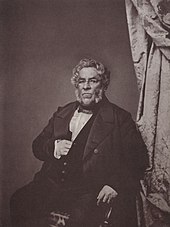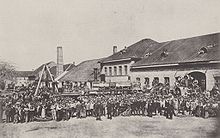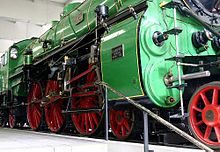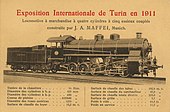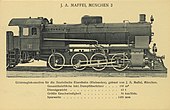Joseph Anton von Maffei
Joseph Anton Ritter von Maffei (born September 4, 1790 in Munich ; † September 1, 1870 there ) was an industrialist. Alongside Joseph von Baader (1763–1835) and Baron Theodor Cramer-Klett (1817–1884), Maffei is considered one of the three important pioneers of the railway in Bavaria.
Life
His parents were Peter Paul (Pietro Paolo) von Maffei (1754-1836), who had lived in Munich since 1770, and his wife Walburga Mayr (1764-1803), a daughter of the snuff manufacturer and councilor Andreas Mayr († 1784) from Munich . His father came to Munich from Trento to run a very successful tobacco wholesaler, which Joseph Anton Maffei continued and later pledged to found the J. A. Maffei machine and locomotive factory.
Joseph Anton Ritter von Maffei married Antonie Schuch (1795–1876), a daughter of the businessman Schuch, in Munich in 1817 . The couple had a daughter. In 1835 Maffei was one of the founding shareholders of the Bayerische Hypotheken- und Wechselbank . Three years later he acquired the Lindauer hammer in Munich and developed it into the J. A. Maffei locomotive and machine factory. Maffei became magistrate in Munich and did a great job a. a. around the construction of the famous Hotel Bayerischer Hof . In 1843 he was the first president of the Munich Chamber of Commerce .
Maffei died in 1870. His nephew Hugo Ritter und Edler von Maffei took over the inheritance .
The tomb of Joseph Maffei is on the old southern cemetery in Munich (Old Arkadenplatz 36 at cemetery 23) location . The original grave is lost due to the destruction in World War II. Bronze panels now hang on the site of the former grave.
Villa Maffei in Feldafing (on Lake Starnberg ), which has been in the possession of the Free State of Bavaria since 1951, was temporarily the seat of the Buchheim Foundation, which manages the Buchheim Museum in Bernried on Lake Starnberg and used the villa for smaller exhibitions and cultural events, making it public made accessible. Its use has been controversial since then.
JA Maffei machine factory
In 1838 Maffei took over the Lindauer'schen Hammer , the Bavarian court hammer forge in Hirschau, the northern part of the English Garden in Munich . The factory was built by the court hammer smith Lindauer in 1814 on the Eisbach - against the bitter resistance of the court garden manager Friedrich Ludwig von Sckell . Maffei continued the company as Eisenwerk Hirschau ( → Lage ) and developed the locomotive and machine factory J. A. Maffei from it. The takeover was initiated in 1837. The Maffei company also often used 1837 as the year it was founded - like its competitors Borsig in Berlin and Keßler in Karlsruhe and Esslingen. Maffei's concern was to make Bavaria competitive in the machine industry. From small beginnings, a locomotive factory of world renown emerged. The following year, the construction of locomotives began.
In 1841 the first steam locomotive with the name Der Münchner was delivered to the Munich-Augsburger Eisenbahn-Gesellschaft for 24,000 guilders.
Maffei sat down u. a. also for the construction of the Munich – Augsburg line and supported Johann Ulrich Himbsel in the construction of the Munich – Starnberg private railway. Maffei was not only active in the railway sector, in 1846 he delivered his steam engine No. 16 (as the first of a total of ten to be employed until 1916) to Ludwig August Riedinger for the operation of the cotton spinning and weaving mill in Augsburg .
In 1851 Maffei delivered the first steamer Maximilian for shipping on Lake Starnberg . By 1926 there were 44 steamships .
The 500th locomotive was delivered in 1864 . Even at that time, Maffei was worried about his workforce, founded a charity fund and provided company retirement pensions.
The locomotive factory J. A. Maffei was able to acquire many international orders. In addition to the production of locomotives, the construction of stationary steam engines and boilers was an important branch of production.
In 1900 the 2000th locomotive was delivered by the Maffeischen factory. It goes to the Royal Bavarian State Railways .
In 1901 the energy supply of the factory in the Hirschau was expanded. To simplify the locomotive transport previously carried out with horse-drawn vehicles, the locomotive factory in Hirschau was given its own siding to Munich-Schwabing station in 1902 .
Well-known products of the locomotive factory are the express train locomotives S 2/6 (speed record 1907: 154 km / h) and S 3/6 , which are still exhibited in the traffic center of the German Museum in Munich and in the Nuremberg Transport Museum.
In 1908 the factory was modernized and new production halls were built.
In 1907/08 , the Maffei-Schwartzkopff works for the production of electrical equipment were built with the Berliner Maschinenbau AG (BMAG / Schwartzkopff ), Wildau near Berlin. The first electric locomotive was delivered in 1910.
After the First World War, locomotives for reparation deliveries were produced from 1918 to 1924. J. A. Maffei expanded the company's social benefits including health and pension insurance.
From 1924 the Maffei-Schwartzkopff-Werke also built diesel locomotives . Further electric locomotives were manufactured from 1925 together with Siemens-Schuckertwerke (SSW) and AEG .
After a failed merger with the Lokomotiv- und Maschinenfabrik Henschel in Kassel, the company was merged with the Lokomotivfabrik Krauss & Comp. AG , also from Munich, amalgamated. Krauss took over the naming and manufacturing program from Maffei, plants and employees from Maffei were not part of the merger. The locomotive factory Krauss & Comp was created. - JA Maffei AG , the production facility was relocated to Allach near Munich , the new company soon traded as Krauss-Maffei . The factories in the Hirschau were sold by the creditors and demolished in 1935. Only the hydroelectric power station remained. Today almost nothing reminds of the locomotive factory in the middle of the park.
Maffei-Schwartzkopff-Werke GmbH in Wildau near Berlin went into liquidation in 1932 .
- Locomotive gallery
Freight locomotive for the Anatolian Railway (Asia Minor)
Freight tender locomotive for the Imperial Japanese State Railways
Locomotive for the Damas-Hama railway line
Passenger locomotive for the Brazilian Central Railway
literature
- Lokomotivfabrik Krauss & Comp. - JA Maffei Aktiengesellschaft Munich (ed.): Hundred years of Krauss-Maffei Munich 1837–1937. Author: Friedrich Möhl, Munich. Production and equipment: R. Oldenburg, book printing and large bookbinding, Glückstraße 8, Munich. Munich 1937.
- Alois Auer (Ed.): Krauss-Maffei. CV of a Munich factory and its workforce . 3K-Verlag, Kösching 1988.
- Johannes Bähr, Paul Erker, Maximiliane Rieder: 180 years of KraussMaffei. The story of a global brand. Siedler Verlag, Munich 2018, ISBN 978-3-8275-0119-6 .
- Willibald Fink: Maffei, Joseph Anton. In: New German Biography (NDB). Volume 15, Duncker & Humblot, Berlin 1987, ISBN 3-428-00196-6 , pp. 645-647 ( digitized version ).
Web links
- Audio portrait of Joseph Anton von Maffei on Bayern2Radio - radioWissen ( Memento from March 29, 2013 in the Internet Archive ) A contribution by Carola Zinner, as of August 13, 2012
- History and production figures of the J. A. Maffei locomotive works
- List of preserved locomotives
- City history of Munich / Eisenwerk Hirschau
Individual evidence
- ^ Fink, Willibald, "Maffei, Josef Anton von" in: Neue Deutsche Biographie 15 (1987), pp. 645–647. Retrieved October 12, 2017 .
- ↑ On the history of the Villa Maffei
- ↑ As of 2013
- ↑ stadtgeschichte-muenchen.de
- ↑ stadtgeschichte-muenchen.de
- ↑ stadtgeschichte-muenchen.de
- ↑ hdbg.eu
- ↑ Süddeutsche Zeitung of September 26, 2013: 175 years of Krauss-Maffei - Two locomotive builders write industrial history, page R10
- ↑ stadtgeschichte-muenchen.de
- ↑ Maffei-Gleis Schwabing ( Memento of the original from October 12, 2016 in the Internet Archive ) Info: The archive link was inserted automatically and has not yet been checked. Please check the original and archive link according to the instructions and then remove this notice. from kocaurek.de, from 2014, accessed on October 12, 2016.
-
^ One hundred years of Krauss-Maffei Munich 1837–1937. P. 26.
Johannes Bähr, Paul Erker, Maximiliane Rieder: 180 years of KraussMaffei. The story of a global brand. Siedler Verlag, Munich 2018, ISBN 978-3-8275-0119-6 . P. 114 ff.
| personal data | |
|---|---|
| SURNAME | Maffei, Joseph Anton von |
| ALTERNATIVE NAMES | Maffei, Joseph Anton Ritter von (full name) |
| BRIEF DESCRIPTION | German industrialist, railway manufacturer |
| DATE OF BIRTH | September 4, 1790 |
| PLACE OF BIRTH | Munich |
| DATE OF DEATH | September 1, 1870 |
| Place of death | Munich |
